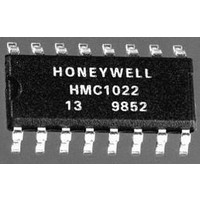HMC1022 Honeywell Microelectronics & Precision Sensors, HMC1022 Datasheet - Page 8

HMC1022
Manufacturer Part Number
HMC1022
Description
Magnetic Sensor
Manufacturer
Honeywell Microelectronics & Precision Sensors
Datasheets
1.HMC1021.pdf
(15 pages)
2.HMC1022.pdf
(15 pages)
3.HMC1022.pdf
(15 pages)
4.HMC1022.pdf
(15 pages)
Specifications of HMC1022
Sensitivity Range
1mV/V/G
Sensor Output
Voltage
Terminal Type
PCB Thru Hole
Output Type
Differential
Sensor Terminals
SMD Gull Wing
Leaded Process Compatible
No
Magnetic Field Max
6G
Axis Configuration
Two
Lead Free Status / RoHS Status
Lead free / RoHS Compliant
Available stocks
Company
Part Number
Manufacturer
Quantity
Price
Company:
Part Number:
HMC1022
Manufacturer:
honeywell
Quantity:
12 800
Part Number:
HMC1022
Manufacturer:
HONEYWE
Quantity:
20 000
Part Number:
HMC1022-TR
Manufacturer:
HITTITE
Quantity:
20 000
LINEAR MAGNETIC FIELD SENSORS
WHAT IS SET/RESET STRAP?
Most low field magnetic sensors will be affected by large
magnetic disturbing fields (>4 - 20 gauss) that may lead to
output signal degradation. In order to reduce this effect, and
maximize the signal output, a magnetic switching technique
can be applied to the MR bridge that eliminates the effect
of past magnetic history. The purpose of the Set/Reset
(S/R) strap is to restore the MR sensor to its high sensitivity
state for measuring magnetic fields. This is done by pulsing
a large current through the S/R strap. The Set/Reset (S/R)
strap looks like a resistance between the SR+ and SR- pins.
This strap differs from the OFFSET strap in that it is
magnetically coupled to the MR sensor in the cross-axis, or
insensitive, direction. Once the sensor is set (or reset), low
noise and high sensitivity field measurement can occur. In
the discussion that follows, the term “set” refers to either a
set or reset current.
When MR sensors exposed to a magnetic disturbing field,
the sensor elements are broken up into ramdonly oriented
magnetic domains (Figure 4A) that leads to sensitivity
degrading. A current pulse (set) with a peak current above
minimum current in spec through the Set/Reset strap will
generate a strong magnetic field that realigns the magnetic
domains in one direction (Figure 4B). This will ensure a high
sensitivity and repeatable reading. A negative pulse (Reset)
will rotate the magnetic domain orientation in the opposite
direction (Figure 4C), and change the polarity of the sensor
outputs. The state of these magnetic domains can retain for
years as long as there is no magnetic disturbing field
present.
The on-chip S/R should be pulsed with a current to realign,
or “flip”, the magnetic domains in the sensor. This pulse can
be as short as two microsecond and on average consumes
less than 1 mA dc when pulsing continuously. The duty
cycle can be selected for a 2 µsec pulse every 50 msec, or
Easy Axis
Permalloy (NiFe) Resistor
Magnetization
Magnetization
Figure 4—
Orientations
Set Pulse
Reset Pulse
Random
Domain
Fig.4A
After a
Fig.4B
Fig.4C
After a
8
longer, to conserve power. The only requirement is that
each pulse only drive in one direction. That is, if a +3.5 amp
pulse is used to “set” the sensor, the pulse decay should not
drop below zero current. Any undershoot of the current
pulse will tend to “un-set” the sensor and the sensitivity will
not be optimum.
Using the S/R strap, many effects can be eliminated or
reduced that include: temperature drift, non-linearity errors,
cross-axis effects, and loss of signal output due to the
presence of a high magnetic fields. This can be accom-
plished by the following process:
• A current pulse, Iset, can be driven from the S/R+ to the
• Another pulse of equal and opposite current should be
• The bridge output, Vout, can be expressed as: Vout
There are many ways to design the set/reset pulsing circuit,
though, budgets and ultimate field resolution will determine
which approach will be best for a given application. A simple
set/reset circuit is shown in Figure 5.
Figure 5—Single-Axis Set/Reset Pulse Circuit (1001)
The magnitude of the set/reset current pulse depends on
the magnetic noise sensitivity of the system. If the minimum
detectable field for a given application is roughly 500
µgauss in HMC1001/2, then a 3 amp pulse (min) is adequate.
If the minimum detectable field is less than 100 µgauss,
then a 4 amp pulse (min) is required. The circuit that
generates the S/R pulse should be located close to the MR
sensor and have good power and ground connections.
The set/reset straps on the Honeywell magnetic sensors
are labeled S/R+ and S/R-. There is no polarity implied
since this is simply a metal strap resistance.
S/R- pins to perform a “SET” condition. The bridge output
can then be measured and stored as Vout(set).
driven through the S/R pins to perform a "RESET" condi-
tion. The bridge output can then be measured and stored
as Vout(reset).
[Vout(set) - Vout(reset)]/2. This technique cancels out
offset and temperature effects introduced by the electron-
ics as well as the bridge temperature drift.
S/R+
S/R-
0.2µF
5,6
7,8
3
1
6-9V
4
2
25K
0.1µF
RESET
RESET state when idle
Signal should be in
SET
Manual Switch
Signal input
5V
RESET
=






















